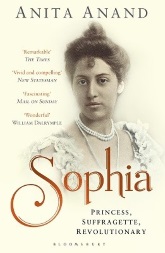Sophia: Princess, Suffragette, Revolutionary
Anita Anand
|
|
In the process of accumulating their Indian empire, the British dispossessed a string of royal families, at times with a brutality that extirpated a royal line, at other times with a bureaucratic insouciance that transported the royal remnants to other climes, where they remained to gnaw at the imperial conscience and coffers as they faded into obscurity. The ancient and last Mughal Emperor was packed off to Rangoon in Burma. The last King of Burma was shipped to the west coast of India. The Begum of Oudh famously ended up in a railway station waiting room. When, in 1849, the East India Company overthrew the boy king Duleep Singh, son of the magnificent Lion of the Punjab, Ranjit Singh, it seemed that the Sikh royal line was about to disappear into history like all the rest. Duleep was sent to London, separated from his mother and the Koh-i-Noor diamond, given an allowance and educated to become what the British hoped would be a Christian English gentleman. In a way, Duleep did become this, but on the way he grew to be a highly attractive youth who captivated his godmother, Queen Victoria. Unfortunately, he coupled his undoubted glamor with a desire for the fleshpots and the fast life which simultaneously endeared him to Victoria’s eldest son, Edward, the Prince of Wales. With the prince for company, Duleep became a rake, but unlike the Prince he had not the funds to pay for it, and his profligacy and arrogance led to bankruptcy.�He seemed set to take his family of two wives and eight children down into the abyss with him. He almost succeeded, but his death left their ruin unfinished, and one of his five daughters was to prove of the mettle of her grandfather. This was the Princess Sophia Alexandrovna Duleep Singh, the Maharaja’s sixth child, whose life followed a pattern quite unique to herself, one of metamorphosis from fashionable society belle, through breeder of dogs and horses to the rescuer of indigent Indian seafarers and then to suffragette and nurse to the injured Indian soldiers of the First World War. Princess Sophia thus provides a biographer with a feast of stories to tell and a huge canvas to explore, some of them historically hugely important, others obscurely exotic. BBC presenter Anita Anand has chosen a peach of a subject on which to write her first book, and she has pulled it off superbly. Anand has clearly come to like her subject and warms to her interests and idiosyncrasies. She treats with great sympathy the sadnesses of Sophia’s early life: her father’s ruin and the eventual evaporation of his social position; the death of a mother reduced at an early age by her husband’s philandering to the solace of the bottle and an alcohol-sodden death; the loss in youth of her favorite youngest brother. She writes scathingly, though with dignified restraint, of the prejudice and bigotry to which the Princess and her siblings were often treated by the British. The British were abominably adept at being rude to their subjects, not just, as EM Forster had it, in railway carriages. Sophia and her sisters were frequent victims of official put downs and social slights, insults that Anand is sensible enough to enumerate, but then to leave us to let our own blood boil. Anand admires the princess’s passionate adherence to women’s rights and to the suffragettes’ fight for the vote. This affection for her subject does not prevent her from seeing Sophia’s faults in an objective light, and she gives criticism where it is due. Yet in general this is the tale of a good woman who overcame the many obstacles in her path and won peace and some contentment at the end, a tale that makes for a very comfortable read. Anand adds to the pleasure of this biography with her fluent way with words. She covers the very different parts of Sophia’s life smoothly and with verbal agility. Covering politics and society in England and her empire over a period of about a century as Anand does, and doing so with so few historical slips, is no mean feat. She succeeds in bringing the period to life, and though a purist may object to some of the generalizations that are found in the detail of this biography, the reader interested in Princess Sophia and the contribution she made to her times will make few bones about them. This is particularly so in Anand’s chapters on the suffragette movement, which have an intensity which can at times be shocking. The suffragette movement has had less attention paid to it in the popular consciousness than it deserves, and the bravery and suffering of many of the women who fought for their rights will be known to few. Anand makes it clear just what that struggle meant to those involved, including her princess, who was in the ranks of her fellows when assaulted by the police and male passers-by outside the House of Commons on what became known as Black Friday, 18 November 1910. That we are thus all in the debt of a Punjabi princess is somewhat of a surprise. Anita Anand is to be congratulated on informing us of this in a biography which will become as standard as it is fast becoming popular.
|

